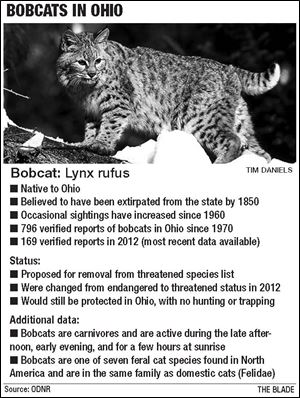
OUTDOORS
Numbers grow, but bobcats keep a low profile in Ohio
1/26/2014

For many years, the bobcat was just a ghost in Ohio, an infrequent apparition that some insisted was present, but had a hard time proving. Bobcats were supposedly dead and gone from the Buckeye State, but over the years a number of people still claimed they had seen one, often for an instant, and then it was gone.
The sightings continued, and increased in frequency, and then when trail cameras came along, the presence of the phantom felines was repeatedly confirmed.
Bobcats are officially back in Ohio, and to the extent that wildlife biologists have recently proposed removing the animal from the state’s threatened species list. They would still be considered a protected species in Ohio, with no hunting or trapping.
“At this point, there are not really threats to their existence,” said Suzie Prange, a biologist with the Division of Wildlife’s office in Athens. “We have studied 23 collared bobcats in our research, and they have been very healthy. Bobcats are doing fine here, and expanding their habitat.”
These solitary, territorial feral cats were common in the Buckeye State when this region was first settled, but as the human population expanded and more land was cleared for crop production, bobcat habitat disappeared and their numbers plummeted. By the middle of the 19th century, bobcats were mostly gone from the state.

About 40 years ago, wildlife biologists started to receive a few intermittent, but often unverified, accounts of bobcat sightings in Ohio. Given their elusive and reclusive nature, it was tough to get proof that Ohio had resident bobcats once again. Verification of their presence usually came only when tracks were clearly identified, bobcats were caught through incidental trapping and then released, or road-killed animals were recovered and examined. Those vehicle-related incidents were the main source of any verified sightings — until about five years ago when the use of trail cameras proliferated.
Trail cameras provided more than half of the 92 verified bobcat sightings in Ohio in 2009, and that number has continued to increase since then. The Ohio Department of Natural Resources had 169 verified bobcat sightings recorded in 2012, taking place in 31 counties. The 2012 numbers, the most-recent data available, showed a third straight year with more that 100 verified bobcat sightings. Hundreds more sightings are considered unverified.
Although a large percentage of the verified sightings in the state take place in the rugged hill country in and around Noble County in southeastern Ohio, sightings have occurred in a variety of locales across the state.
For several decades, bobcats are believed to have been migrating into Ohio from Michigan to the north, Indiana to the west, Kentucky to the south, and West Virginia and Pennsylvania to the south and east. Adult females are extremely intolerant of other females in their home range, so animals are regularly on the move looking for new territory.
“Their numbers are increasing every year,” Prange said, while adding that many of Ohio’s current population of bobcats were born here.
“We have a population that is growing steadily. We expect that to level off eventually, once they have occupied all the potential habitat, but for now we’re seeing a steady increase.”
There has also been more physical proof that bobcats are increasing their numbers and expanding their range. That includes a body count, which confirmed the presence of a bobcat in the Secor Metropark area in 2013.
Last summer, the road-killed animal was picked up along Central Avenue, a couple miles west of I-475/U.S. 23 and near the park. Although there have been numerous sightings in this area that were classified as unconfirmed, the Toledo bobcat was the second confirmed one in northwest Ohio in recent years — in 2011 one was caught in Williams County in a snare trap set for raccoons.
A necropsy performed on the Metropark bobcat confirmed it was a wild animal, not a pet that had escaped or been released.
Bobcats are about twice the size of the average house cat, and as adults weigh from 11-30 pounds. Named for its short tail, which gives the appearance of being “bobbed,” the bobcat has long legs for its body size, large paws, and tufts on its ears that are similar to those of its somewhat larger cousin, the Canadian lynx.
Bobcats were on Ohio’s first endangered species list back in 1974, but as their numbers grew and the verified sightings increased, their status was changed from endangered to threatened in 2012. These are ferocious hunters that will take down larger prey, but they feed primarily on birds, mice, rabbits, squirrels and other small animals.
In Michigan, where bobcats have had a much stronger presence historically, limited hunting and trapping takes place in certain counties in the Upper Peninsula and the northern third of the Lower Peninsula. There is no bobcat hunting or trapping permitted anywhere south of Saginaw Bay.
MIDWEST OPEN: The public is invited to attend the weigh-in at the conclusion of the Midwest Open Ice Fishing Tournament, which is scheduled for today on Wamplers Lake in the Irish Hills region of Michigan. The weigh-in will take place starting at 2:30 this afternoon at Columbia Central High School in Brooklyn.
Contact Blade outdoors editor Matt Markey at: mmarkey@theblade.com or 419-724-6068.